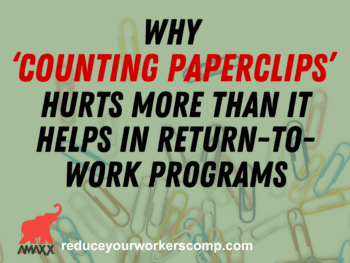
Benefits of Reporting Injuries in a Timely Manner
Countless studies demonstrate the benefits of the timely injury report. This includes the following:
- Prompt medical care for the injured employee;
- Accurate recording of information concerning the incident;
- Preservation of evidence; and
- Compliance with state and federal requirements regarding workplace safety.
Problems arise when the person charged with injury investigation and reporting is not given the proper training and tools to respond to the incident.
Click Link to Access Free PDF Download
“13 Research Studies to Prove Value of Return-to-Work Program & Gain Stakeholder Buy-In”
Responsibilities in Injury Reporting
Every supervisor and manager should receive training in responding to a work injury and making sure it is reported in an accurate and timely manner. This can include the following functions:
- Proper medical care: This goes beyond being training in first aid. It entails understanding how to obtain medical care for an employee following an injury. Tools to make available can include establishing a local primary care medical facility and access to telephonic triage medical management.
- Completion of forms: Many forms might need to be completed following a work injury. This can include a First Report of Injury, OSHA forms, and a company-developed injury form. All documents need to be fully completed and filed with the correct persons or agencies.
- Invitation of Injury Investigation: This investigation needs to include the basics and demand additional steps for the proper preservation of evidence. In some instances, this can consist of the requirement of drug and alcohol testing as allowed under state law.
Interested stakeholders should ensure supervisors and other managers have the proper training to complete these essential steps.
Document, Document, Document
Documentation is key when it comes to an effective injury response on the part of a supervisor. There are many items to consider when it comes to following policies and procedures and ensuring everything is completed:
- Understanding and following injury response protocols;
- Contacting all interested internal (and external) stakeholders regarding the work injury;
- Documenting the employee’s ability to work and return to work; and
- Notifying the responsible person that all post-injury steps have been completed.
Now is the time to ensure all supervisors within your organization understand their role and have the proper training for documenting a work injury.
Post-Injury Follow-up and Return to Work
Supervisor and midlevel managers play many important roles in a post-injury response following the acute phase of a work injury. Failure to take these steps can sour workplace morale and delay a timely return to work.
FREE DOWNLOAD: “13 Research Studies to Prove Value of Return-to-Work Program & Gain Stakeholder Buy-In”
There are several essential items supervisor can make following a work injury:
- Follow-up and contact with the injured employee: Sending a simple “get well soon” card goes a long way. Other steps can include weekly check-ins to identify any problems with the workers’ compensation process, such as a lack of response from the insurance carrier.
- Development of a Return-to-Work Plan: A vast majority of injured employees have a desire to get back to work as soon as possible. The injured employee’s supervisor can play an important role in developing a plan to get the employee back to work in a suitable role.
- Injury prevention: It is also important for the supervisor to identify remedial action that can take place internally to avoid future work injuries. This can include modification of roles and improvement in safety. Supervisors need to be given a voice when addressing these issues with management.
A complete post-injury response that places emphasis on return to work is essential to every workers’ compensation program.
Conclusions
Reducing workers’ compensation program costs starts with an effective injury investigation conducted by a supervisor who understands what needs to be done and how to do it promptly. This investigation needs to include a timely and accurate report of the incident that provides for complete documentation. It also requires post-injury efforts with a focus on getting the employee back to work. When done properly, it can lead to increased workplace morale and a better workers’ compensation program.
 Author Michael Stack, CEO Amaxx LLC. He is an expert in workers’ compensation cost containment systems and helps employers reduce their workers’ comp costs by 20% to 50%. He works as a consultant to large and mid-market clients, is a co-author of Your Ultimate Guide To Mastering Workers Comp Costs, a comprehensive step-by-step manual of cost containment strategies based on hands-on field experience, and is the founder & lead trainer of Amaxx Workers’ Comp Training Center, which offers the Certified Master of Workers’ Compensation national designation.
Author Michael Stack, CEO Amaxx LLC. He is an expert in workers’ compensation cost containment systems and helps employers reduce their workers’ comp costs by 20% to 50%. He works as a consultant to large and mid-market clients, is a co-author of Your Ultimate Guide To Mastering Workers Comp Costs, a comprehensive step-by-step manual of cost containment strategies based on hands-on field experience, and is the founder & lead trainer of Amaxx Workers’ Comp Training Center, which offers the Certified Master of Workers’ Compensation national designation.
Contact: mstack@reduceyourworkerscomp.com.
Workers’ Comp Roundup Blog: https://blog.reduceyourworkerscomp.com/
©2021 Amaxx LLC. All rights reserved under International Copyright Law.
Do not use this information without independent verification. All state laws vary. You should consult with your insurance broker, attorney, or qualified professional.
FREE DOWNLOAD: “13 Research Studies to Prove Value of Return-to-Work Program & Gain Stakeholder Buy-In”
















